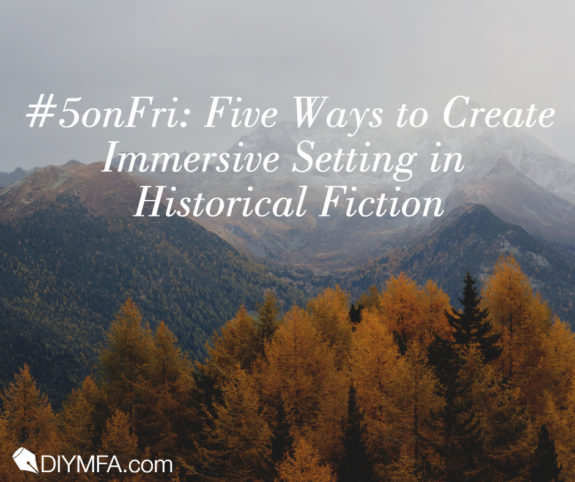Creating an immersive setting is an important element of any story, but it’s especially important for historical fiction writers. Readers come to this genre because they want to feel they’re stepping out of their world and into the world of your story, whether it takes place in Gilded Age New York, Renaissance Florence or Imperial China.
Setting is a collection of details—the right details in the right amount. It involves curating the essential elements of the characters’ surroundings for the reader. In other words, immersive setting is not about expanding; it is about narrowing. Narrow the reader’s focus on what matters most and the place will come alive.
Here are five ways you can create immersive setting when writing historical fiction (or any fiction, really).
1) Develop vivid sensory details
Call on all of your characters’ senses. We rely heavily on sight when describing anything from our appearance to a sentimental piece of jewelry to a visit to the beach, so it feels natural to extend this comfort zone to our stories. Challenge yourself to include senses other than sight.
In an effort to incorporate the other senses, you may find yourself stumbling into cliché with overused descriptions such as:
- The wail of the siren
- The warm flush in her cheeks
- The fresh pine (Why is pine always touted as fresh?)
I’m sure you can think of others. These clichés steal from your story because there is nothing fresh (like pine, apparently) or innovative here. The reader ends up skimming over them.
Try this: Close your eyes and pretend you’re in the scene with your characters. Imagine it’s 1924 Paris or 1898 Puerto Rico. What would you be smelling, hearing, tasting or touching? What does your character notice? What is one element that would stand out to your character?
2) Reveal character emotions through place
Setting is personal. Your characters live there. I’ve edited many manuscripts where the setting feels like it was torn from the pages of a guidebook or taken directly from the author’s experience with the place. That is a good starting point, but description should be filtered through your character’s perspective.
Try this: Consider your character’s emotional state and relationship to the location. For example, a noble in Marie Antoinette’s court is in a different state of mind than her lady-in-waiting who has a different perspective than a peasant living hand-to-mouth. How would the mood of the place change for each character? How would the narrator’s word choice differ?
3) Create a setting that acts as a character
This is ultimately what we want, isn’t it? We want the reader to feel the setting of our story is so rich that it has a personality all its own. Every place, like every character, has a past, which informs its present. Without knowing about that past, the setting can feel untethered, not rooted to anything important.
Try this: Explore the setting’s backstory. There. I’ve used the B-word. Don’t be afraid to include a bit of the place’s history. (Note: this doesn’t mean pages upon pages that have no bearing on the character.) Consider how the history has affected your character through social or personal experiences. Does he or she have to make a decision with this past in mind? How can you use your setting’s history to target conflict in the present?
4) Make setting a catalyst for the characters’ actions
Dynamic settings are about change. If something changes in a character’s environment, she may be forced to take action. A few years ago, I wrote a short story about a hurricane that devastated the Florida Keys in 1935. The storm touched every person who lived on the islands, and it forced every character to make tough choices about what to do next. The setting played an active role in moving the story forward.
Try this: You don’t need to include a natural disaster to have the setting act as a catalyst for change. Add or subtract an important element in the location. Maybe your character uncovers something previously unknown to her like the lovely park statues are cameras in disguise, watching her every move. Or maybe the power supply to the town goes out, plunging everyone into darkness. Then what do your characters do?
5) Utilize macro and micro setting
Setting exists on two levels for the reader and for the characters. Macro is the overarching location of place. China 1949. Boston 1776. The Dust Bowl. Each of these evokes an emotional response in the reader just by virtue of naming it. Micro setting, on the other hand, happens on the sentence level. Word choice and sensory images affect how the reader interprets the setting. Snow can be blustery or delightful. Heirloom pearls can be nostalgic or a burden. The difference is how your character perceives these details and how you present them to the reader.
Try this: Dive into historical documents. You can very likely find a library archive that relates to your period and subject, and many are now online. Some have primary sources and photos available. The New York Public Library’s Digital Collection could be a great place to start. But remember that less is more. Don’t be tempted to include every detail you unearth. Only include that which moves your story forward.
Building immersive setting is about weaving a dream for readers so they feel they’re stepping out of their world and into the world of your story. Let me know how these suggestions work for you!
 Jacquelin Cangro is a book editor, creative writing instructor, and writing coach with 20 years of experience at Penguin Random House. She helps writers develop the confidence and skills they need to get their stories on the page. Visit her site to find many resources to improve your writing, including her e-course Writing About Place. Find her on Instagram @jcangro and in her Facebook group.
Jacquelin Cangro is a book editor, creative writing instructor, and writing coach with 20 years of experience at Penguin Random House. She helps writers develop the confidence and skills they need to get their stories on the page. Visit her site to find many resources to improve your writing, including her e-course Writing About Place. Find her on Instagram @jcangro and in her Facebook group.







